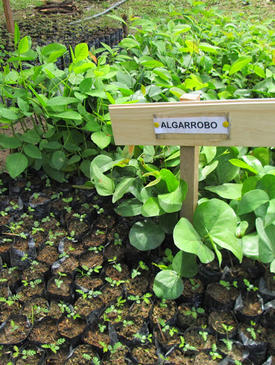Technical Aspects of Plant Material Production
Summary
Conventional cattle ranching practices are often considered as being a primary driver of deforestation and land degradation. However, there are strategies that can help to make this practice more sustainable.
The Colombian Cattle Ranching Association (FEDEGAN-FNG), in partnership with the Center for Research on Sustainable Agriculture Production Systems (CIPAV), The Nature Conservancy (TNC) and The Environmental and Childhood Action Fund (FPAA), is implementing the Mainstreaming Biodiversity in Colombian Cattle Ranching project (known as GCS). This seven-year project (2010-17) focuses on five geographic regions of Colombia and strives to ensure that cattle ranching systems contribute to the sustainable use of natural resources.
The GCS project expects to conserve 5,495 hectares of forest, while transforming 51,000 hectares of pasture into diverse silvopastoral systems (SPS) (Calle et al., 2013)1. It is estimated that to achieve this goal, approximately 4.5 million seedlings – including native species and species of global interest for conservation – will need to be produced.
Given the complexity of the GCS project, building the capacity of their staff and partners in relevant areas is vital to the project’s success. As a result, ELTI worked with FEDEGAN-FNG to design a field-based training-of-trainers course entitled, Technical Aspects of Plant Material Production. This course trained personnel responsible for the planting strategy of the GCS project on the basics of forest ecology and ecological restoration, the fundamental techniques and strategies of seedling propagation in nurseries, administrative aspects of nursery management and practical exercises for planting seedlings in the field.
Content
Module 1. Conceptual bases of ecology and natural regeneration of tropical forests
- Biodiversity and restoration in productive landscapes
- Basic concepts of ecological restoration
- Alternative methods and techniques of low cost forest restoration
- Selection and propagation of tree species in the Colombian Sustainable Cattle Ranching Project
Module 2. Techniques and propagation strategies of seedlings for ecological restoration
- Genetic diversity in the production of plant material - Part 1
- Genetic diversity in the production of plant material - Part 2
- Methods and techniques for the production of plant material
- Field trip #1: Visit to identify seed trees for collecting seeds of native species and seedlings, harnessing and storage
Module 3. Administrative and management aspects of tree nurseries
- Production of native seedlings (nursery management and planting processes)
Module 4. Production technology
- Field trip #2 – Part 1: Visit to observe the production of seedlings in a basic nursery
- Field trip #2 – Part 2: Visit to observe the operational activities in the production of a nursery (mixing substrate, filling the bags or tubes, transplanting seedlings to bags, etc.)
- Tree nurseries as an opportunity for agrobusiness in rural communities
- Restoration models with the possibility of economical use to attract rural producers
Module 5. Environmental, social and financial dimensions of sustainability and its relevance in the restoration of cattle ranching landscapes
- Field trip #3: Planting exercise and observation of nursery material on the field


